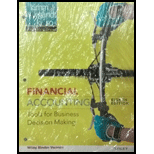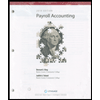
Revenue recognition principle:
In revenue recognition principle, the revenue is recognized for the accounting period in which, the goods are sold, or the services performed. Once the goods are sold, or services performed for a particular period, the business recognizes the revenue.
Expense recognition principle:
The expense recognition principle follows the same theory of revenue recognition principle. In expense recognition principle, the expense is recognized for the same period in which, the revenue is recognized. In other words, expenses incurred during the period to earn certain revenues are recognized.
To determine: The expenses to be deducted from the revenue.
Want to see the full answer?
Check out a sample textbook solution
Chapter 4 Solutions
Bundle: Financial Accounting: Tools for Business Decision Making 8e Binder Ready Version + WileyPLUS Registration Code
- What is the amount of net sales?arrow_forwardHello tutor please give answer asap for this accounting problemsarrow_forwardViggo Manufacturing estimates that overhead costs for the next year will be $2,800,000 for indirect labor and $750,000 for factory utilities. The company uses machine hours as its overhead allocation base. If 100,000 machine hours are planned for this next year, what is the company's plantwide overhead rate?arrow_forward
- An asset was purchased for $72,000 with a salvage value of $6,000 on July 1, Year 1. It has an estimated useful life of 6 years. Using the straight-line method, how much depreciation expense should be recognized on December 31, Year 1?arrow_forwardPlease help me solve this general accounting question using the right accounting principles.arrow_forwardWhat is its degree of operating leverage?arrow_forward
- A firm reported wages expense of $607 million and cash paid for wages of $578 million. What was the change in wages payable for the period?arrow_forwardPlease provide the solution to this financial accounting question using proper accounting principles.arrow_forwardI need help with this problem and accounting questionarrow_forward
 College Accounting (Book Only): A Career ApproachAccountingISBN:9781337280570Author:Scott, Cathy J.Publisher:South-Western College Pub
College Accounting (Book Only): A Career ApproachAccountingISBN:9781337280570Author:Scott, Cathy J.Publisher:South-Western College Pub
 Individual Income TaxesAccountingISBN:9780357109731Author:HoffmanPublisher:CENGAGE LEARNING - CONSIGNMENT
Individual Income TaxesAccountingISBN:9780357109731Author:HoffmanPublisher:CENGAGE LEARNING - CONSIGNMENT





